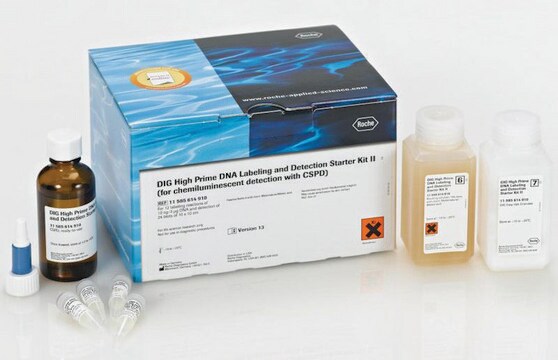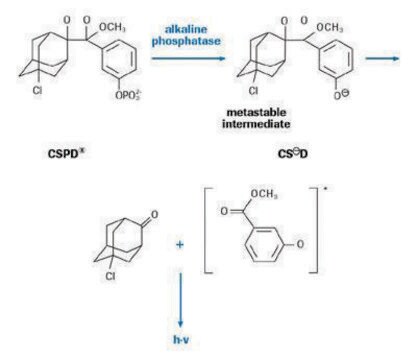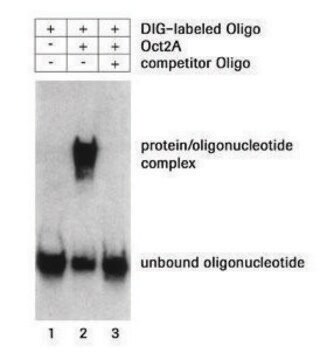11175041910
Roche
DIG Nucleic Acid Detection Kit
sufficient for 40 blots (10 cm x 10 cm each), kit of 1 (5 components), suitable for hybridization, suitable for Northern blotting
Sinonimo/i:
DIG system
About This Item
Prodotti consigliati
impiego
sufficient for 40 blots (10 cm x 10 cm each)
Livello qualitativo
Confezionamento
kit of 1 (5 components)
Produttore/marchio commerciale
Roche
Caratteristiche più verdi
Designing Safer Chemicals
Learn more about the Principles of Green Chemistry.
sustainability
Greener Alternative Product
tecniche
Northern blotting: suitable
Southern blotting: suitable
hybridization: suitable
Categoria alternativa più verde
, Aligned
Temperatura di conservazione
−20°C
Descrizione generale
Applicazioni
- Southern blots
- Northern blots
- Other nucleic acid blotting applications
- In situ hybridization applications
- Southern blots
- Northern blots
- Other nucleic acid blotting applications
- In situ hybridization applications
Caratteristiche e vantaggi
Confezionamento
Principio
Nota sulla preparazione
Working concentration of conjugate depends on application and substrate.
Storage conditions (working solution):
- Anti-Digoxigenin-AP Conjugate (vial 3): 2 to 8 °C, it is stable for 12 months at this temperature
- NBT/BCIP (vial 4): 2 to 8 °C, stable
Note: During shipment of the kit on dry ice, a precipitate may occur which is dissolved by briefly warming to 37 °C - The blocking reagent (vial 5) is stable for 36 months and can be stored dry at 4 to 8 °C.
- Autoclaved stock solution can be stored for several days to a week either unopened at 15 to 25 °C or at 4 to 8 °C after opening. Alternatively, it can be stored in aliquots at -15 to -25 °C for up to 6 months.
Solo come componenti del kit
- DIG-labeled Control DNA 5 µg/ml
- DNA Dilution Buffer, [50 μg/ml] fish sperm DNA
- Anti-Digoxigenin-AP Conjugate antibody 750 U/ml
- NBT/BCIP, 50x stock solution 50x concentrated
- Blocking Reagent
Codice della classe di stoccaggio
11 - Combustible Solids
Classe di pericolosità dell'acqua (WGK)
WGK 3
Punto d’infiammabilità (°F)
does not flashNot applicable
Punto d’infiammabilità (°C)
does not flashNot applicable
Certificati d'analisi (COA)
Cerca il Certificati d'analisi (COA) digitando il numero di lotto/batch corrispondente. I numeri di lotto o di batch sono stampati sull'etichetta dei prodotti dopo la parola ‘Lotto’ o ‘Batch’.
Possiedi già questo prodotto?
I documenti relativi ai prodotti acquistati recentemente sono disponibili nell’Archivio dei documenti.
I clienti hanno visto anche
Articoli
Digoxigenin (DIG) labeling methods and kits for DNA and RNA DIG probes, random primed DNA labeling, nick translation labeling, 5’ and 3’ oligonucleotide end-labeling.
Il team dei nostri ricercatori vanta grande esperienza in tutte le aree della ricerca quali Life Science, scienza dei materiali, sintesi chimica, cromatografia, discipline analitiche, ecc..
Contatta l'Assistenza Tecnica.









